Power Plant Men Summoned by Department of Labor
Favorites Post #72
Originally posted August 30, 2014.
When a death or a near death occurs at a workplace due to an accident, OSHA (Occupational Safety and Health Administration) will investigate what happened. There are two reasons for this. If they find that the company has been negligent in following the safety regulations set down in CFR 1910, then they are fined (if the negligence is severe enough). OSHA also investigates the accident to see if changes are needed to regulations in order to protect employees due to new unsafe workplace conditions that are not currently covered under CFR 1910.
Because of the tragedy that happened at our plant that I outlined in the post: “Tragedy Occurs During Power Plant Safety Meeting” and after I had met with the OSHA man (Gerald Young) to give him my deposition as discussed in the post last week: “The OSHA Man Cometh“, the plant manager, the assistant plant manager, and I were summoned to the Department of Labor building in Oklahoma City at 10 o’clock on Monday April 18, 1994.
On a side note:
The Department of Labor office in Oklahoma City is just a couple of blocks from the Murrah Federal Building that was bombed exactly one year and one day after our visit on April 19, 1995. Not that there was any connection.
I mentioned this because I went to the Murrah building later that day after the meeting with OSHA to meet my brother for lunch. He was working there in the Marine Recruiting office at the time. I think he was a Major then. He changed jobs in June 1994 and moved to Washington D.C.. His replacement was killed in the bombing. Here he is Greg today as a full Marine Colonel:
End of Side Note:
I was asked by Ron Kilman our plant manager to show up at 9:00 am on Monday in the building south of our main corporate headquarters where we rented office space to meet with the guys from our own Safety Department because they were required to attend the OSHA meeting with us. The Department of Labor building was just across the parking lot and across the street from this building, so we planned to walk from there.
I drove myself because Ron said he had other meetings to attend in Oklahoma City after this meeting was over and he wouldn’t be driving back to the plant. That was why I arranged to have lunch with my brother. I figured that word had gone out from Tom Gibson that I talk a lot during long trips, and he just wanted some peace and quiet that morning.
When we met with the Corporate Safety Department Jack Cox told us how we should act during the meeting with OSHA. He didn’t tell us to do anything wrong, like withhold information. He just told us to answer all the questions as truthfully as we could. Don’t offer any information that isn’t directly asked by OSHA. Don’t argue with them if you disagree.
From what I understood from the conversation, we were supposed to be polite, truthful and don’t waste their time going down a rat hole with specifics. I was told that I shouldn’t have to say anything and I should be quiet unless I was asked a specific question. The Safety department would answer all the questions and make any statements that need to be made. I was assured by them that I had nothing to be worried about. I only needed to tell the truth if asked anything.
If you know my personality, I always want to throw in my 2 cents, even when I know it is wasted on the audience. But I took this seriously. We were going to be fined by OSHA for 10 different violations relating to the accident that occurred at the plant. I was there because I was directly in charge of the work that was being done when the accident occurred. It was my deposition that was used to determine about half of the violations.
After we had been briefed on how we should behave during the meeting, as a group we walked from the corporate building over to the Department Of Labor building. One of the safety guys was carrying a few binders. I think one was the company’s Policies and Procedures book (We called it the GP&P).
Upon entering the building we went to the 3rd floor where we were asked to wait in a room until OSHA was ready for the meeting. The room had a long table down the middle. As usual, I picked a seat about halfway down on one side. I remember Ron Kilman sitting across from me and about 2 seats down.
We waited and we waited….. 10:00 came and went, and no one came. We quietly discussed whether this was to make us more nervous by keeping us waiting. Then someone came to the door and apologized. They said that Robert B. Reich, the U.S. Secretary of Labor was in the office that day and that had thrown off everyone’s schedule.
This was quite a coincidence, and we wondered if Robert B. Reich (it seems like you need to put the B in his name in order to say it right) would be attending our meeting. That would sort of throw a whole new importance of me keeping my mouth shut to make sure I wasn’t putting my foot in it.
It seemed as if Mr. Reich had shown up unexpectedly. Or at least on short notice. Almost as if it was a surprise visit to check up on the place. He didn’t end up coming to our meeting. Now that I think about it. This was one day shy of being one year to the date that the Branch Davidians had burned themselves alive in Waco, which was one year and one day before the Murrah Building Bombing three blocks away from where we were sitting that morning. Aren’t coincidences interesting? Just saying…
More about why Robert B. Reich was there further below.
Around 10:30 four or five OSHA lawyers (I assume they were lawyers, they talked like they were), came in the room along with the Jerry that had interviewed me a few weeks earlier. They apologized again for being late due to the arrival of their “supreme” boss. They sort of sat at one end of the room and the people from our company was more on the other end. Jerry, the OSHA man, sat next to me in the middle.
I was saying a mantra to myself…. “Don’t say anything… just keep quiet and listen…. don’t say anything… just keep quiet and listen.
The meeting began by the Lady at the end of the table reading off the violations to us. I don’t remember all 10. I remember the most important violations. They mainly centered around the new Confined Space section of 1910. It was 1910.146 that dealt with confined spaces and it had gone into affect April 1, 1993, almost one year before the accident happened. Generally, OSHA gives companies about a year to comply to the new regulations, which kind of put us right on the edge since the accident at our plant had occurred on March 3, 1994.
Because of this, some of the violations were quickly removed. That lowered the number down to 6 violations right away. That was good. No one from our company had said a word yet, and already the OSHA lawyers seemed to be on our side. Then they read off a violation that said that our company had not implemented the required Confined Space Program as outlined in CFR 1910.146.
This was when our Safety Department leader, Jack Cox. said that we would like to contest that violation, because here is the company policy manual that shows that we implemented the Confined Space Program before the end of the year.
One of the OSHA lawyers responded by saying that we had not fully implemented it because we had not trained the employees how to follow the policy. When he made that statement, Ron Kilman contested it.
He had a stack of papers that showed that each of the employees at the plant had taken the training and had signed a paper saying they had read the policy. Not only that, but the person that was hurt was not a company employee, they were an outside vendor who was hired by the company to vacuum out the hoppers.
The OSHA man said that just because they took the course did not mean that they were properly trained. Ron asked how do you know they weren’t properly trained. The OSHA man replied, “Because they didn’t follow all the rules. If they had, no one would have been hurt.” — What do you say to that? You can tell we weren’t properly trained because someone was hurt? I suppose that the OSHA rules were written in such a way that if you followed them to the letter, no matter what kind of mechanical failure happens, no one will be hurt. I could see the frustration on Ron’s face.
I was a little amused by Ron’s statement though because Jack Cox had told us to just let them answer all the questions and the first seemingly absurd thing the OSHA man had said, Ron had addressed. — I smiled and said to myself…. “Don’t say anything… just keep quiet and listen…”
One of the violations was that we didn’t have a Confined Space Rescue Team. That was true, we didn’t. There was something in the regulations that said, if a rescue team could arrive in a reasonable time from somewhere else, we didn’t have to have our own rescue team…. Well, we lived 20 miles from the nearest fire station equipped with a Confined Space Rescue team. So, there was that…. That was a legitimate violation.
The next violation was that we didn’t have a rescue plan for every confined space in the plant and each confined space was not clearly marked with a Confined Space sign. This was a legitimate violation.
The next violation was that we hadn’t coordinated efforts between different work groups working in confined spaces together. This was clearly stated in the regulations…. — Oh oh. that was me… I think I was mid-mantra when I heard that one. I had just said to myself… “…anything….just keep….” when I heard this violation. I stopped muttering to myself and immediately forgot that I was supposed to keep quiet.
I said, “But wait a minute. We did coordinate between the three groups that were working in the confined spaces. I was coordinating that. I had posted a sheet on a beam in the middle of the hopper area where the accident occurred where the Brown and Root contractors, and the vacuum truck contractors knew what hoppers were still full and which were safe to enter.
I kept the sheet updated each day and so did the vacuum truck workers. They indicated when they had finished vacuuming out a hopper, and I would inspect it from above. When I deemed it safe, the Brown and Root contractors could enter the space. The accident occurred because one of the vacuum truck workers entered the confined space while still cleaning it out and before I had inspected it to make sure it was safe.”
Jerry (the OSHA man that had interviewed me turned and said, “Oh. I didn’t know that. Do you still have that piece of paper?” — Incredibly, I did. About a week after all the vacuuming had finished and all the hoppers were safe, I was walking through the hopper area under the precipitator where I found the paper with the duct tape still on it laying on the grating. Without realizing the importance, I picked it up and brought it back to the janitor closet behind the electric shop that we now used as a “Precipitator Fly Ash Cleanup Room”. I had laid it on a shelf there. The lawyers said, “Send us the original sheet and we will drop this violation.
Here is a copy of the piece of paper. The big black splotch at the top is what duct tape looks like when you make a copy of it.
Well, that worked out good. I had stepped out of line by opening my mouth before I had been asked a question, but everything worked out all right.
The final verdict was that we had four violations. We had to re-train our employees on Confined Spaces. We had to create a Confined Space Rescue Team. We had to put the correct signs on all of the confined spaces and we had to develop rescue plans for all of the confined spaces on the plant grounds. If we did that by August 1, 1994, the four remaining violations which amounted to a $40,000 fine would all be dropped. So, we had our work cut out for us. This not only impacted our plant, but all the Power Plants. The meeting was adjourned.
I already told you what I did after the meeting (I went and ate lunch with my brother). But I haven’t mentioned yet why Robert B. Reich had made a surprise visit to the Department of Labor building in Oklahoma City on April 18.
As it turned out, that morning, Labor Secretary Reich had come to Oklahoma City to hand deliver a $7.5 million fine to Dayton Tire Company. This was due to an accident that had resulted in a man, Bob L. Jullian, being crushed by a piece of machinery in the tire plant. He died a week and a half later at the age of 53.
Robert B. Reich had become so angry when he had studied the case on Friday that he wanted to hand deliver the citation himself the following Monday. That is how we ended up in the building at the same time on Monday, April 18, 1994. We resolved our dispute with OSHA on a congenial note and the citations were dropped on August 1. Dayton, however, was still fighting the conviction 18 years later, eventually paying around a $2 million penalty.
Now you know the rest of the story. Well, almost. Like I said, we had a lot of work to do in the next three and a half months.
Why Do Power Plant Men always Lose the Things they Love the Most?
Originally posted November 9, 2013:
One of the things I loved the most about being an electrician at the coal-fired Power Plant in North Central Oklahoma was that I spent a good deal of time troubleshooting and fixing Electronic Circuit boards. My Mentor Bill Rivers had taught me the fine art of repairing precipitator circuit boards to the point where I was very comfortable taking a board with burned out circuits and rebuilding it piece at a time until it worked well enough to be put back into service. There is something comforting about fixing electronic circuit boards.
I had even built a little test box out of a proximity switch on a Gaitronics phone receiver hook where I could plug a large Operational Amplifier into it and turn a little knob to test it, where it would light up little red LEDs. Like I said. It was really fun.
I had told my friend from High School, Jesse Cheng, who was now a doctor just graduating from Harvard with his Masters in Public Health how much fun I was having. Even though he was a medical doctor with an Engineering degree from Yale, he wished that he could do what I was doing. He even applied for an Engineering job at our plant so that he could at least come down to the electric shop where I would let him help me troubleshoot and repair all kinds of electronic circuit boards.
Unfortunately, he was overqualified for the job. Louise Gates asked me about him, since he had listed me as a reference on the job application. I explained to her that even though he was a Medical Doctor, what he really wanted to do was work in a power plant with the great bunch of people I had told him about. He would easily have given up his career to be blessed by the presence of such great Power Plant Men.
I will tell a side story about my Friend Jesse, before I proceed with the painful loss of those things that Power Plant Men love….
I met Jesse when I was a sophomore in High School. He was the student body president when I arrived at Rockbridge High School in Columbia, Missouri. We immediately became friends when we met. We both enjoyed the same things. The main thing was playing games, or solving puzzles.
I quickly learned that Jesse loved playing all kinds of games. So, when I would go over to his house, we would usually go down in the basement where he had a new game waiting for me. We would sit down there and play games until his mother would call us for dinner.
One day my brother came with me and we went down in the basement to play the game of Risk.
Jesse was beating us so badly that after the 3rd move, we joined forces only to have Jesse wipe us off of the map on the 4th turn. Then his mother called us for dinner.
Jesse’s mother was a small Chinese lady with a meek voice. When Jesse had guests over, she would cook his favorite meal. Chili. So, when it was time for dinner, she would call down to us from the top of the basement stairs, “Jesse! Come get your Chili!” I had heard that call to action many times, and I had obediently left whatever we were playing to go eat supper.
After we had finished dinner and talked with Jesse for a while, my brother and I left to go home. On the way home my brother started to chuckle. I asked him why, and he responded that he could still hear Jesse’s mother calling “Jesse! Come get your Chili!” in his head. It sounded funny to hear the small Asian voice calling to Jesse to come get his Chili.
So, that became a catch phrase for when you wanted to holler at someone, but didn’t have anything particular to say. We would just yell out, “Jesse! Come get your Chili!!” It always brought a smile to the faces of anyone who knew the story, and a confused look on the faces of any bystanders.
When I went to Columbia, Missouri to the University of Missouri, I told this story to the people that lived around me in Mark Twain Dormitory. I would smile when I would be heading back to the dorm after class and someone from a block away would spy me from their dorm window and would yell at the top of their lungs, “Jesse! Come get your Chili!!!”
Jesse was in town one day shortly after the Christmas break and came to visit me in the dorm. He walked off the elevator looking for the room where I lived. The Resident Assistant saw him and immediately asked him, “Are you Jesse Cheng?” When he replied that he was, he said, “Kevin is in Room 303.” When I answered the door, Jesse said he couldn’t figure out how everyone on the floor seemed to know who he was. I told him that “Everyone knows you Jesse! You’re my friend!”
So, there were times when I was at the plant where a Power Plant Man (or Woman) would yell to me, “Jesse! Come get your Chili!” No one can say that without a big smile on their face, and on mine. It’s poetry to my ears. Jesse’s mother forever lives on in our memories.
End of Side Story….
So, why am I talking about troubleshooting electronic circuit boards in a post about Power Plant Men losing the things they love most? Well… because all good things had to come to an end. Electronic circuit boards included.
When I went to search for a picture of an electronic circuit board on Google Images, I had to page down a couple of times before I found a partial picture of a circuit board that had capacitors, resistors and diodes on it. They just aren’t used much anymore. Everything has gone digital. Instead of troubleshooting electronic parts, you diagnose signals being sent between various processors and memory chips. It just isn’t quite the same.
So, lucky for Jesse that he wasn’t hired at our plant. By the time he would have showed up, we were no longer changing out transistors. We were programming chips. Now the circuit boards looked more like this:
Other things in the electric shop were taken away or became “unused” that I used to really enjoy using. We had a heat gun mounted on the wall where we would heat up bearings in order to put them on the shaft of the motor. We would stand there monitoring the bearing to see if it was hot enough… We would spit on our finger and drip the spit on the bearing. When the spit would sizzle, we knew the bearing was hot enough.
There was something comforting about the smell of hot grease from the bearing mixed with the smell of smoldering spit… Also in the winter, it felt good to warm yourself around the heat gun while you waited for the bearing to heat up.
Well. Eventually, we no longer used the heat gun. We had a fancier bearing heater that looked like a strange aluminum cone hat.
The bearing heater heated the bearing more uniformly, and we could use a special temperature pencil that would melt when the bearing reached the right temperature. No more boiling bearing grease smell, and no smoldering spit. Oh well….
When the bearing was the right temperature, we had a pair of large white Asbestos Gloves that we would wear to pick up the bearing and slap it onto the shaft of the motor. The pair of Asbestos gloves in our shop came from the old Osage Plant. They were made from genuine Asbestos. I suppose a white cloud of Asbestos dust would fly up in your face if you were overly moved by the song on the radio in the shop and felt a sudden urge to clap.
Well… You can imagine what happened to our Asbestos gloves. Those gloves that you knew were going to keep your hands from being burned as you picked up the scalding hot bearing. You never had to worry about being burned…. but…. oh well… They were taken away. Not deemed safe for use by humans.
In the shop when before and after we took apart a motor, we performed a test on the motor called, “Meggering the motor”. That is, we clipped a megger to the motor leads and one to the motor case and cranked a hand crank on the side of the Megger to generate 1,000 volts to see if the insulation in the motor was still good.
Meggers are much like an old telephone from way back, where you would turn a crank to call the operator. Or you could take it fishing with you and shock the fish in the water to make them float to the surface. But…. I wouldn’t know about that. I just heard stories from other Power Plant Men about it.
A manual crank megger was similar….
Alas…. After a while, a Meggar with a crank became a thing of the past, as did our Simpson Volt-Ohm Meter:
It wasn’t only electric shop equipment that the Power Plant Men held dear that kept disappearing. We used to wear safety belts at the plant to keep us from falling off of high places. Would you believe that these Safety Belts were taken away from the Power Plant Men as well?
I explained how the electronic circuit boards were replaced with digital cards. I also explained how the heat gun was replaced with a nifty new bearing heater, which was also almost made obsolete by another invention called an Induction heater.
This heater didn’t even get hot. The bearing would heat up by a magnetic field on the bar that would cause an electric current to build up around the bearing, causing it to heat up almost by magic.
The Asbestos Gloves were replaced with well padded Kevlar Gloves:
They worked just as well as the asbestos gloves without the Mesothelioma thrown in as a bonus.
As for the volt-ohm meters. Each electrician was eventually issued their own new Fluke Volt-Ohm Meter. I dare say. It was a step up from the old Simpson meter. A lot safer also:
And the Safety belt? Well… It turns out that if someone were to fall and be hanging from a safety belt, the injury caused by just dangling for any length of time on a safety belt while waiting to be rescued can be devastating to the human body. So, the belts were removed, and Power Plant Men everywhere were issued new and improved Safety Harnesses.
So… you see… What it boils down to is this…. Power Plant Men generally love their jobs. Real Power Plant Men I mean. So, whenever there is change, they feel the pain of loss. They lose those things they hold dear. Yeah. They know that whatever is replacing the things they are losing will most likely be a new and improved version of what they already had. I think it’s the nostalgia of how things used to be that they miss the most.
So. That is why Power Plant Men always seem to lose the things they love the most. Because they love doing what they do, and things are always changing. Power plant Men just change right along with it. But sometimes it hurts a little
Comments from original post:
-
Great story, Kevin.
When I transferred to the Seminole Plant, one of my jobs was to do the “daily sheets”. For each generating unit I calculated total MW, steam flow, gas burned, average temperatures and pressures, etc. We were privileged to have the first non-mechanical calculators in an OG&E Power Plant. The old calculators (I used at Mustang and Horseshoe Lake) were mechanical – motors, gears, shafts, levers, dials, and more gears. They made cool sounds when you hit the “Total” key. They even had a unique smell too. We paid $900 for each Monroe calculator in 1970. They didn’t make any noises. They didn’t give off any scent, either. But they were much faster, smaller, and lighter. I missed the old mechanicals. I still have the Post slide rule I used at OU too. -
Sadly, change is progress. I used a blackboard, now it’s a white board!
-
I loved your post, change comes in our lives but hopefully in our lives we blossom and become better for it, and always cherish the memories. I smiled a thousand times while reading it and will always remember “Jessie come eat your chili! Blessings!
-
Change, yes…but it’s more than that. Old time craftsmen involved a lot of themselves in their work. I remember men who grabbed a wire to determine the voltage on it. A lot of work was done by feel, a sort of extra sense that craftsmen developed on the job. Projects came out right because they knew what was intended and how to make it happen that way. They were an important link in the chain of production.
Now so much work is untouched by human hands; merely moved along by button-pushers who have replaced true craftsmen. An old time carpenter or electrician could do things today’s replacements never dream of. Cabinet makers and machinists are gone, replaced by machine operators. Much is no doubt gained, but so much is lost…
An average man in those days, was pretty competent with his hands, expected to have a list of skills and competencies…and that’s gone, too.
Power Plant Women and the EEOC Shuffle
Originally posted November 30, 2013:
While I worked as a janitor at the coal-fired power plant in North Central Oklahoma the subject came up one Monday morning about the normal career path that janitors could take. We had already been told that the only place a janitor could advance to was the labor crew. We had also been told that there was a company policy that came down from Oklahoma City that only allowed janitors to move to the labor crew before they could move on to another job like an Operator or Mechanic.
I had been trying to decide if I wanted to go the route of being an Operator or a Mechanic during my time as a janitor. That is, until Charles Foster asked me if I would be interested in becoming an Electrician. I hadn’t even considered being an electrician up to that point, as I had no experience and it seemed like a job that needed a particular skill set.
I had begun my studies to learn about being an electrician when there was an opening in the Electric Shop. Charles Foster and Bill Bennett petitioned to hire me for the position, but the verdict came down from above that according to Company Policy, a janitor could only advance from janitor to the labor crew.
I didn’t have any expectation at the time of becoming an electrician given that I had no experience, so I wasn’t disappointed when Mike Rose was hired from outside the company. He was hired to help out Jim Stevenson with Air Conditioning and Freeze Protection.
The next revelation about our position as janitor at the plant (and I’m sure that Ron Kilman, our next plant manager, who reads this blog can testify that it really was company policy…. after all…. that’s what our plant manager told us. — Just kidding…. I know that it really wasn’t), was that when it became our turn to move from being a janitor to moving to the labor crew, if we didn’t move to the labor crew during the next two openings on the labor crew, then we would be let go. I mean… we would lose our job.
This revelation came about when Curtis Love was next in line to go to the labor crew and he was turned down. Larry Riley, the foreman of the labor crew had observed Curtis while we were being loaned to the labor crew during outages and he didn’t want him on the crew for um…. various reasons. After Curtis had been turned down, he was later told that if he didn’t move onto the labor crew when there was another opening, then the company had to fire him. It was company policy (so we were told…. from Corporate Headquarters).
I had been around the plant long enough to know at that point that when we were told that it was company policy that came down to us from Corporate Headquarters, that, unless it was in our binders called General Policies and Procedures, then it probably wasn’t really company policy. It was more likely our evil plant manager’s excuse for not taking the responsibility himself and just telling us that this was the way it was, because he just said so….
Anyway… This caused a dilemma from an unlikely source on our team of janitors. Doris Voss became worried that if she didn’t move onto the labor crew, that she would lose her job. She was quite content at the time to have just stayed a janitor, but from this policy that had just come down from Corporate Headquarters, (i.e. The front corner office of our plant), she either had to go to the labor crew, or lose her job.
So, what Doris decided to do was to apply for the job of receptionist that had just been vacated by Grant Harned (see the post “Power Plant Carpooling Adventures with Grant Harned“). Doris applied for the job and her application was accepted. She moved on to work at the receptionist desk. I, on the other hand, was next in line behind Curtis Love. So, when he was turned down for the labor crew, I took his place.
As a side note, I talked Larry Riley into letting Curtis Love advance to the labor crew when there was another opening. I told him that I would let him work with me, and that I would take care of him. With that caveat, Larry agreed. You can read a couple of adventures I had with Curtis after he arrived on the labor crew by reading these posts: “Power Plant Safety as Interpreted by Curtis Love” and “Angel of Death Passes by the Precipitator Door“. Later, however, when I had moved on to be an electrician, Curtis was let go after having a vehicle accident and not reporting it right away.
What does this have to do with the EEOC shuffle? Well… about the time I have moved on to the labor crew, a new company-wide policy had been put in place for the internal “Employee Job Announcement Program”. Our power plant had some “irregularities” surrounding where our new employees were coming from. It seems that an inordinate amount of new employees were coming from Pawnee, and more particularly from a certain church. It was obvious to some that a more “uniform” method needed to be in place to keep local HR staff from hiring just their buddies.
Along with this, came a mandate that all external job announcements had to be sent to various different unemployment offices in a certain radius in order to guarantee that everyone that was interested had the opportunity to be informed about any new positions at the plant well in time to apply for it. That was, if the Internal job announcement program didn’t find any viable candidates within the company that was willing to take the job.
EEOC, by the way, means, Equal Employment Opportunity Commission. Around the same time that our plant had hired a “snitch” to go around an entrap unsuspecting employees into illegal activities (see the post: “Power Plant Snitch“), the EEOC had given us notice that we were not hiring enough women and American Indians as well as African Americans at the plant. Not only did we lack number, we also needed to have them spread out into a number of different jobs in the plant.
At the time the operators were 100% male. No women. The maintenance shop had a couple of women. The rest of the women at the plant were either clerks, working for the warehouse, or in the HR department…. Which all incidentally reported up to Jack Ballard our HR Supervisor. Well. Except for Yvonne Taylor in the Chemistry lab, and maybe someone that was on the testing team and of course Summer Goebel who was a Plant Engineer.
It wasn’t just women that were affected. We had to have an African American in Upper Management. Bill Bennett had become an A Foreman a few years earlier, and there was some discussion about whether they could promote him up one more level. He refused the offer. Later they decided that an A Foreman at our plant was high enough to be considered “upper management”.
American Indians were also a group of employees that needed to fill a certain quota. The Power Plant was located in North Central Oklahoma with many Indian Reservations surrounding it. I think we were supposed to have more than 10% American Indians employed at the plant. So the front office asked everyone to check to see if they were Indian enough to be considered. I think if you were 1/16th American Indian, you counted in the quota.
Some people were a little disturbed to be asked to report their racial status in order to fill a quota. Jerry Mitchell told me that he was Indian, but that he never had told anyone and he didn’t want to become a number, so he wasn’t going to tell them. I think we met our quota even without Jerry Mitchell and some others that felt insulted.
At the time, we had over 350 employees at the plant. That meant that we needed 35 women. I think we were closer to 25 when the push to hire more women went into effect.
The problem area that needed the most work was with the operators. Their entire organization had no women and they were told that they needed them. The problem was both structural and operational (yeah…. Operations had an operational problem…. how about that?).
There were two problems with hiring women to be operators. The first one was structural. The operators main base was the Control Room. That’s where their locker room was. That’s where their kitchen was. More importantly that’s where they could all stand around and watch Gene Day perform feats of magic by doing nothing more than standing there being…. well… being Gene Day!
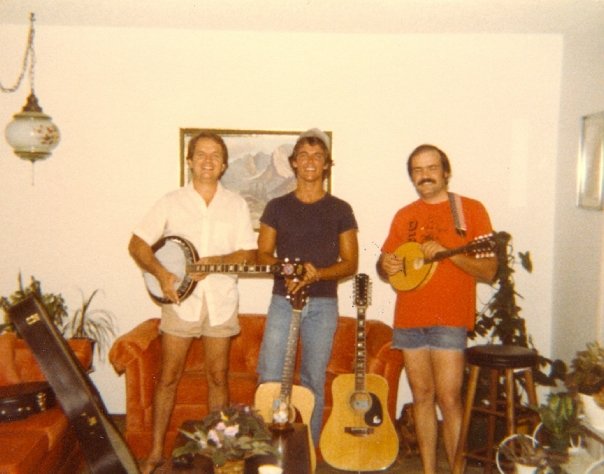
Yipes. Notice how comfortable Jim Cave is standing between Gene Day and Joe Gallahar! Gene Day is the one with the Banjo and the more hairier legs. — I couldn’t resist…
There was only a Power Plant men’s locker room. There were no facilities for women. The nearest women’s rest / locker room was across the main plant in the office area, or downstairs in the Maintenance shop. This presented a logistical problem, especially on days when Gene Day made his special Chili or tortilla soup (Ok, I’m just picking on Gene Day…. We all know Gene never could cook. We loved him anyway).
Either way, there were times when taking a trek across the plant to make it to the nearest restroom was not acceptable. This was solved by building an additional rest / locker room in the control room for women operators. That problem was solved.
The operational problem inherent in operations was that they worked shift work. That is, each week, they shifted the hours they worked. Operators had to be working around the clock. So, one week, they would work from 7:00 am to 3:30 pm. Next week they may work from 3pm to 11:30pm, or from 11pm to 7:30am. The plant didn’t have any female applicants for a job where you had to work around the clock.
The EEOC said that wasn’t good enough. We needed to find women to work in operations. This was where Doris Voss became a person of interest.
Doris was asked if she would like to become an operator. Of course, she said no. She really still wanted to be a janitor, but was content being a receptionist. I’m not sure what she was told or was given, but she eventually agreed and moved over to become an operator. Another clerk, Helen Robinson was later coaxed into becoming an operator. Mary Lou Teeman was also hired into the Operations department. I don’t remember if she was a clerk before that, or if she was a new hire. — I do remember that she was the sweetest lady in operations.
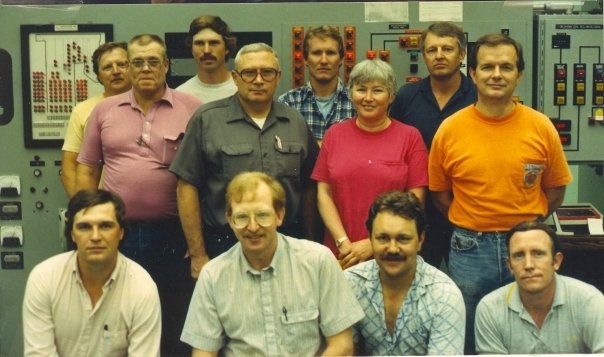
Gene Day is the one standing on the right with the Orange shirt and longer pants than above (see what I mean about him being “instant Entertainment?). Mary Lou Teeman is standing next to him in the red shirt.
Here is a picture that includes Doris Voss:
And here is Helen Robinson:
How is it that Charles Peavler showed up in two pictures? — Oh. Taken at different times. Note that Charles Peavler with the gray shirt in the front row is kneeling on one knee, but Larry Tapp with the blue shirt next to him is standing….. Hey. Larry Tapp may be short, but he’s one of the nicest guys in this picture. I have a story about those two guys on the right side of this picture. Merl Wright and Jack Maloy. I’ll probably include that as a side story in a later post (See the post: “Power Plant Conspiracy Theory“).
With the addition of the three new female operators, the EEOC shuffle was satisfied. We had added a few new female employees from the outside world and everyone was happy. Julienne Alley was added to the Welding shop during this time. The entire maintenance crew would agree that their new “Shop” mother was the best of them all (See the post: “Power Plant Mother’s Day“).
Comment from the Original Post:
-
I don’t know what “policies” Martin Louthan agreed to with the two coal plant managers. I remember them talking about how hard it was keeping good workers in their Labor crews. We didn’t have Labor crews at the gas plants so we weren’t affected. When I moved to Sooner, I don’t remember that “policy” (terminated after 2 turn-downs to Labor crew) being in place. Was it?
No. It was just a policy created specifically to target one person. It was never enforced.
Power Plant Men Summoned by Department of Labor
Originally posted August 30, 2014.
When a death or a near death occurs at a workplace due to an accident, OSHA (Occupational Safety and Health Administration) will investigate what happened. There are two reasons for this. If they find that the company has been negligent in following the safety regulations set down in CFR 1910, then they are fined (if the negligence is severe enough). OSHA also investigates the accident to see if changes are needed to regulations in order to protect employees due to new unsafe workplace conditions that are not currently covered under CFR 1910.
Because of the tragedy that happened at our plant that I outlined in the post: “Tragedy Occurs During Power Plant Safety Meeting” and after I had met with the OSHA man (Gerald Young) to give him my deposition as discussed in the post last week: “The OSHA Man Cometh“, the plant manager, the assistant plant manager, and I were summoned to the Department of Labor building in Oklahoma City at 10 o’clock on Monday April 18, 1994.
On a side note:
The Department of Labor office in Oklahoma City is just a couple of blocks from the Murrah Federal Building that was bombed exactly one year and one day after our visit on April 19, 1995. Not that there was any connection.
I mentioned this because I went to the Murrah building later that day after the meeting with OSHA to meet my brother for lunch. He was working there in the Marine Recruiting office at the time. I think he was a Major then. He changed jobs in June 1994 and moved to Washington D.C. I think. His replacement was killed in the bombing. Here he is Greg today as a full Marine Colonel:
End of Side Note:
I was asked by Ron Kilman our plant manager to show up at 9:00 am on Monday in the building south of our main corporate headquarters where we rented office space to meet with the guys from our own Safety Department because they were required to attend the OSHA meeting with us. The Department of Labor building was just across the parking lot and across the street from this building, so we planned to walk from there.
I drove myself because Ron said he had other meetings to attend in Oklahoma City after this meeting was over and he wouldn’t be driving back to the plant. That was why I arranged to have lunch with my brother.
When we met with the Corporate Safety Department Jack Cox told us how we should act during the meeting with OSHA. He didn’t tell us to do anything wrong, like withhold information. He just told us to answer all the questions as truthfully as we could. Don’t offer any information that isn’t directly asked by OSHA. Don’t argue with them if you disagree.
From what I understood from the conversation, we were supposed to be polite, truthful and don’t waste their time going down a rat hole with specifics. I was told that I shouldn’t have to say anything and I should be quiet unless I was asked a specific question. The Safety department would answer all the questions and make any statements that need to be made. I was assured by them that I had nothing to be worried about. I only needed to tell the truth if asked anything.
If you know my personality, I always want to throw in my 2 cents, even when I know it is wasted on the audience. But I took this seriously. We were going to be fined by OSHA for 10 different violations relating to the accident that occurred at the plant. I was there because I was directly in charge of the work that was being done when the accident occurred. It was my deposition that was used to determine about half of the violations.
After we had been briefed on how we should behave during the meeting, as a group we walked from the corporate building over to the Department Of Labor building. One of the safety guys was carrying a few binders. I think one was the company’s Policies and Procedures book (We called it the GP&P).
Upon entering the building we went to the 3rd floor where we were asked to wait in a room until OSHA was ready for the meeting. The room had a long table down the middle. As usual, I picked a seat about halfway down on one side. I remember Ron Kilman sitting across from me and about 2 seats down.
We waited and we waited….. 10:00 came and went, and no one came. We quietly discussed whether this was to make us more nervous by keeping us waiting. Then someone came to the door and apologized. They said that Robert B. Reich, the U.S. Secretary of Labor was in the office that day and that had thrown off everyone’s schedule.
This was quite a coincidence, and we wondered if Robert B. Reich (it seems like you need to put the B in his name in order to say it right) would be attending our meeting. That would sort of throw a whole new importance of me keeping my mouth shut to make sure I wasn’t putting my foot in it.
It seemed as if Mr. Reich had shown up unexpectedly. Or at least on short notice. Almost as if it was a surprise visit to check up on the place. He didn’t end up coming to our meeting. Now that I think about it. This was one day shy of being one year to the date that the Branch Davidians had burned themselves alive in Waco, which was one year and one day before the Murrah Building Bombing three blocks away from where we were sitting that morning. Aren’t coincidences interesting? Just saying…
More about why Robert B. Reich was there further below.
Around 10:30 four or five OSHA lawyers (I assume they were lawyers, they talked like they were), came in the room along with the Jerry that had interviewed me a few weeks earlier. They apologized again for being late due to the arrival of their “supreme” boss. They sort of sat at one end of the room and the people from our company was more on the other end. Jerry, the OSHA man, sat next to me in the middle.
I was saying a mantra to myself…. “Don’t say anything… just keep quiet and listen…. don’t say anything… just keep quiet and listen.
The meeting began by the Lady at the end of the table reading off the violations to us. I don’t remember all 10. I remember the most important violations. They mainly centered around the new Confined Space section of 1910. It was 1910.146 that dealt with confined spaces and it had gone into affect April 1, 1993, almost one year before the accident happened. Generally, OSHA gives companies about a year to comply to the new regulations, which kind of put us right on the edge since the accident at our plant had occurred on March 3, 1994.
Because of this, some of the violations were quickly removed. That lowered the number down to 6 violations right away. That was good. No one from our company had said a word yet, and already the OSHA lawyers seemed to be on our side. Then they read off a violation that said that our company had not implemented the required Confined Space Program as outlined in CFR 1910.146.
This was when our Safety Department leader, Jack Cox. said that we would like to contest that violation, because here is the company policy manual that shows that we implemented the Confined Space Program before the end of the year.
One of the OSHA lawyers responded by saying that we had not fully implemented it because we had not trained the employees how to follow the policy. When he made that statement, Ron Kilman contested it. He had a stack of papers that showed that each of the employees at the plant had taken the training and had signed a paper saying they had read the policy. Not only that, but the person that was hurt was not a company employee, they were an outside vendor who was hired by the company to vacuum out the hoppers.
The OSHA man said that just because they took the course did not mean that they were properly trained. Ron asked how do you know they weren’t properly trained. The OSHA man replied, “Because they didn’t follow all the rules. If they had, no one would have been hurt.” — What do you say to that? You can tell we weren’t properly trained because someone was hurt? I suppose that the OSHA rules were written in such a way that if you followed them to the letter, no matter what kind of mechanical failure happens, no one will be hurt. I could see the frustration on Ron’s face.
I was a little amused by Ron’s statement though because Jack Cox had told us to just let them answer all the questions and the first seemingly absurd thing the OSHA man had said, Ron had addressed. — I smiled and said to myself…. “Don’t say anything… just keep quiet and listen…”
One of the violations was that we didn’t have a Confined Space Rescue Team. That was true, we didn’t. There was something in the regulations that said, if a rescue team could arrive in a reasonable time from somewhere else, we didn’t have to have our own rescue team…. Well, we lived 20 miles from the nearest fire station equipped with a Confined Space Rescue team. So, there was that…. That was a legitimate violation.
The next violation was that we didn’t have a rescue plan for every confined space in the plant and each confined space was not clearly marked with a Confined Space sign. This was a legitimate violation.
The next violation was that we hadn’t coordinated efforts between different work groups working in confined spaces together. This was clearly stated in the regulations…. — Oh oh. that was me… I think I was mid-mantra when I heard that one. I had just said to myself… “…anything….just keep….” when I heard this violation. I stopped muttering to myself and immediately forgot that I was supposed to keep quiet.
I said, “But wait a minute. We did coordinate between the three groups that were working in the confined spaces. I was coordinating that. I had posted a sheet on a beam in the middle of the hopper area where the accident occurred where the Brown and Root contractors, and the vacuum truck contractors knew what hoppers were still full and which were safe to enter. I kept the sheet updated each day and so did the vacuum truck workers. They indicated when they had finished vacuuming out a hopper, and I would inspect it from above. When I deemed it safe, the Brown and Root contractors could enter the space. The accident occurred because one of the vacuum truck workers entered the confined space while still cleaning it out and before I had inspected it to make sure it was safe.”
Jerry (the OSHA man that had interviewed me turned and said, “Oh. I didn’t know that. Do you still have that piece of paper?” — Incredibly, I did. About a week after all the vacuuming had finished and all the hoppers were safe, I was walking through the hopper area under the precipitator where I found the paper with the duct tape still on it laying on the grating. Without realizing the importance, I picked it up and brought it back to the janitor closet behind the electric shop that we now used as a “Precipitator Fly Ash Cleanup Room”. I had laid it on a shelf there. The lawyers said, “Send us the original sheet and we will drop this violation.
Here is a copy of the piece of paper. The big black splotch at the top is what duct tape looks like when you make a copy of it.
Well, that worked out good. I had stepped out of line by opening my mouth before I had been asked a question, but everything worked out all right.
The final verdict was that we had four violations. We had to re-train our employees on Confined Spaces. We had to create a Confined Space Rescue Team. We had to put the correct signs on all of the confined spaces and we had to develop rescue plans for all of the confined spaces on the plant grounds. If we did that by August 1, 1994, the four remaining violations which amounted to a $40,000 fine would all be dropped. So, we had our work cut out for us. This not only impacted our plant, but all the Power Plants. The meeting was adjourned.
I already told you what I did after the meeting (I went and ate lunch with my brother). But I haven’t mentioned yet why Robert B. Reich had made a surprise visit to the Department of Labor building in Oklahoma City on April 18.
As it turned out, that morning, Labor Secretary Reich had come to Oklahoma City to hand deliver a $7.5 million fine to Dayton Tire Company. This was due to an accident that had resulted in a man, Bob L. Jullian, being crushed by a piece of machinery in the tire plant. He died a week and a half later at the age of 53.
Robert B. Reich had become so angry when he had studied the case on Friday that he wanted to hand deliver the citation himself the following Monday. That is how we ended up in the building at the same time on Monday, April 18, 1994. We resolved our dispute with OSHA on a congenial note and the citations were dropped on August 1. Dayton, however, was still fighting the conviction 18 years later, eventually paying around a $2 million penalty.
Now you know the rest of the story. Well, almost. Like I said, we had a lot of work to do in the next three and a half months.



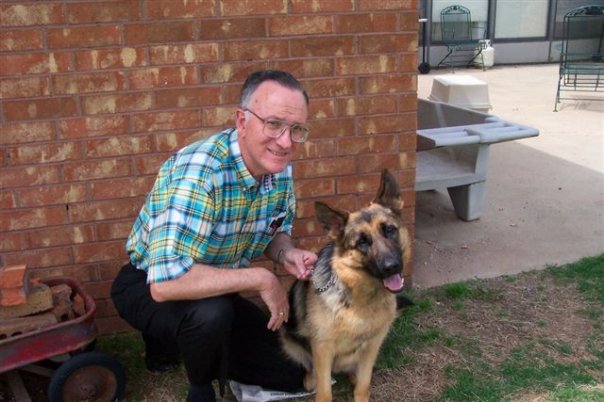

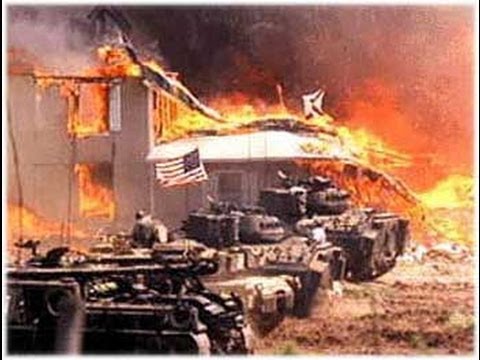









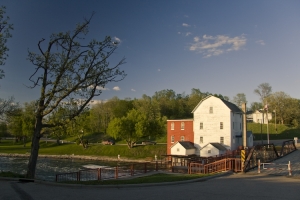
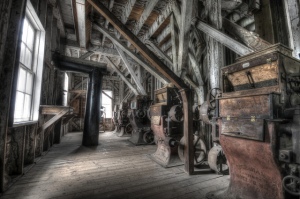


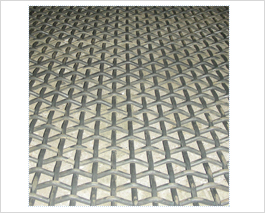


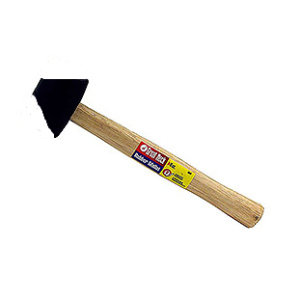





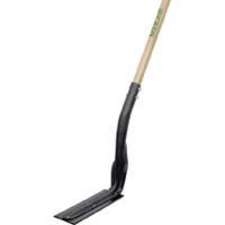
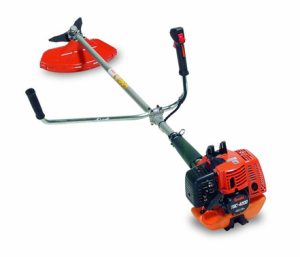
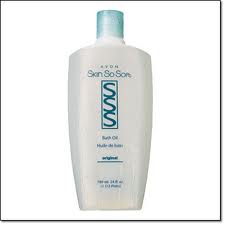





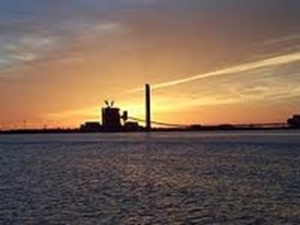

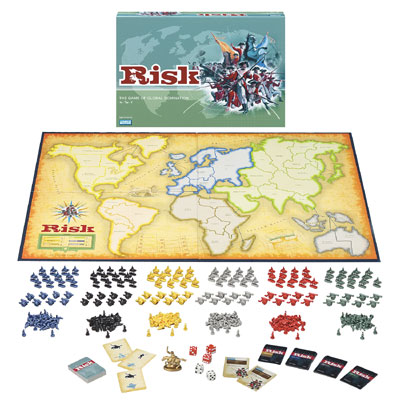



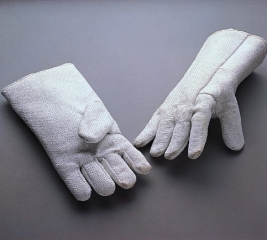




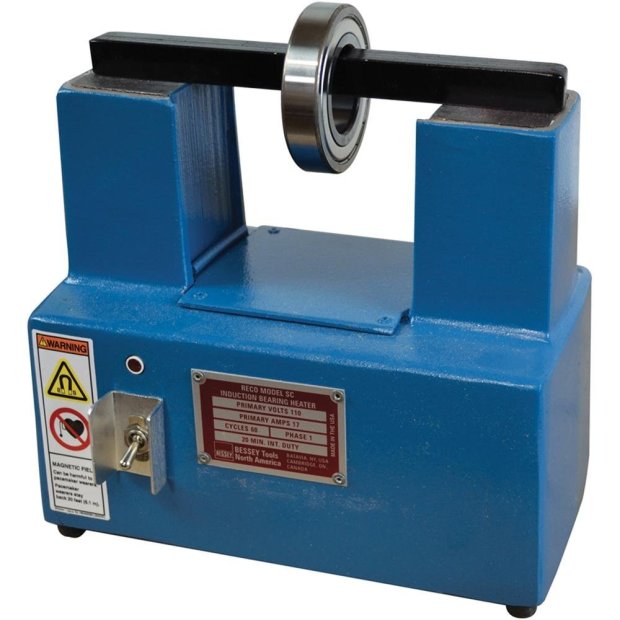



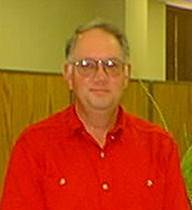

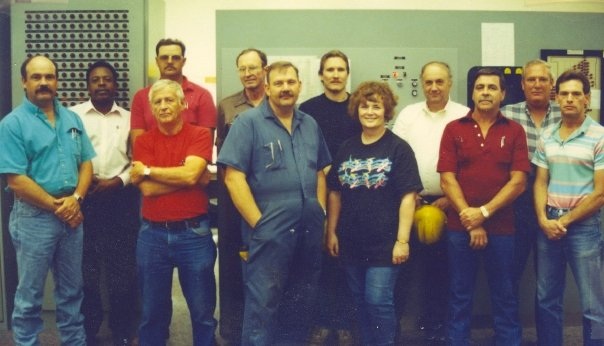
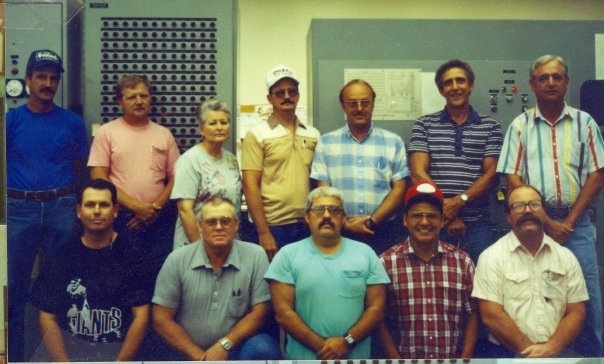



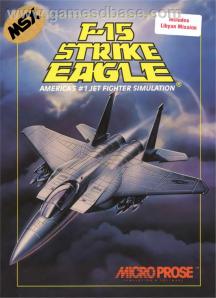

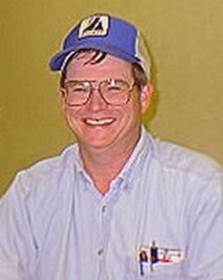
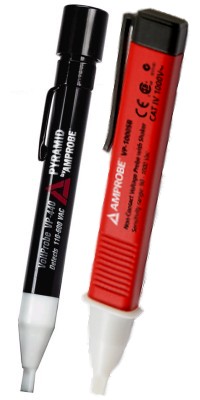

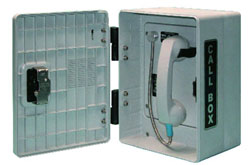
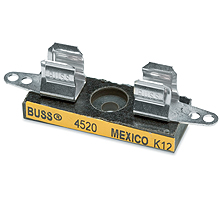
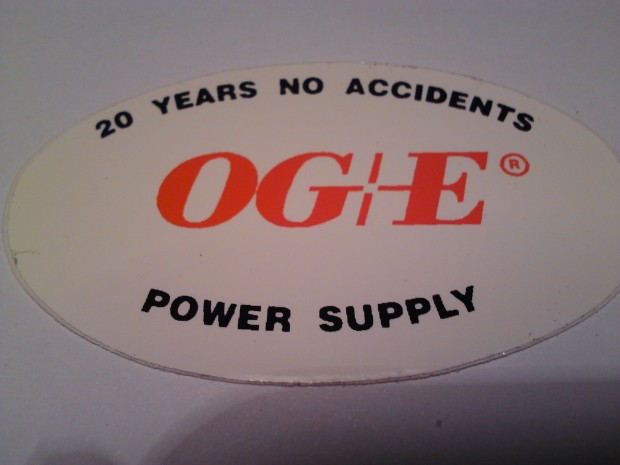

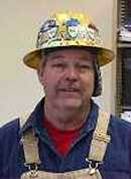


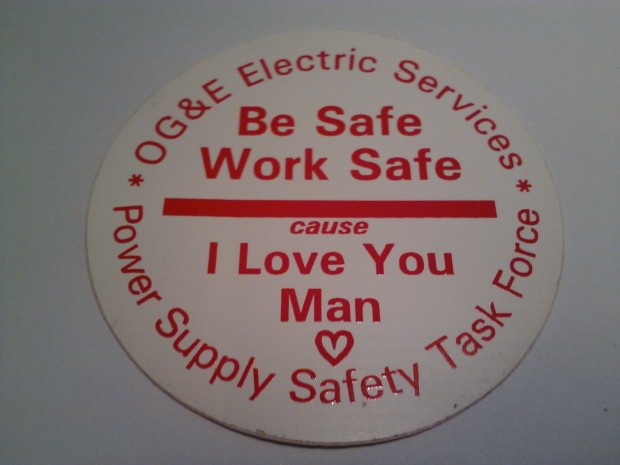
Thanks! I had not heard of Gilbert’s passing.
Yes, the old plants had full pressures to the gauges in the control room (throttle, extractions, reheat (if any), even condenser vacuum). The funniest “gauge” I ever saw was at the Byng Power Plant (north of Ada). It was the plant MW output “gauge”. When the control room operator changed load, he would move the dial on the “gauge” (with his hand) and ring a buzzer. The men firing the boilers would hear the buzzer, look through the glass window at the new plant MW output, and change the firing rate on the boilers accordingly!
That’s a great story about the MW output gauge! This reminds me of the throttle control on large older ships. The round thing with the handle that the captain would turn to change the speed of the ship. This actually called an “Engine Order Telegraph” that rings a bell when the setting is changed so the Engine room knows to look at the new setting and then does what it takes to make the ship go faster or slower, or even to change from forward to reverse. In the movies it looks like it just happens automatically.